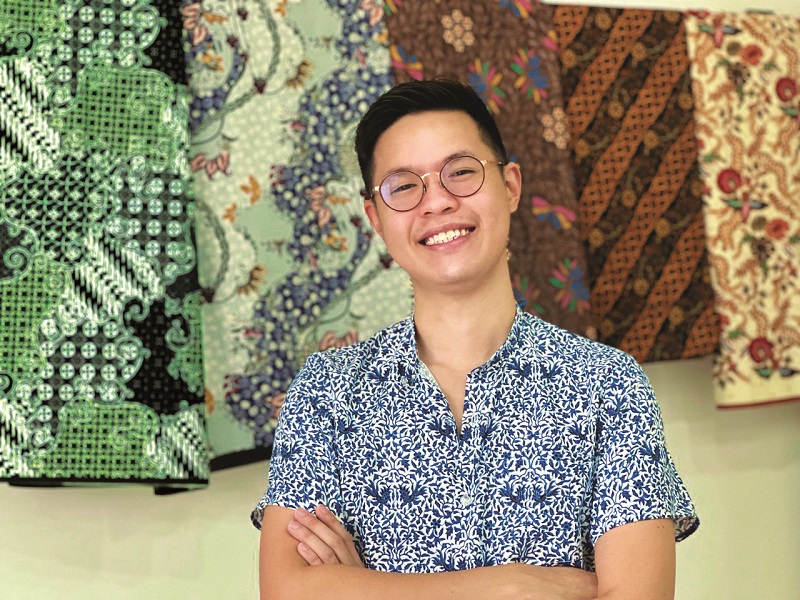
inisaya celebrates all kinds of batik prints, whether they are from Malaysia or Indonesia (All photos: inisaya)
Jeffery Goh grew up surrounded by fashion, thanks in part to his family. His grandmother sewed clothes for her children, his mother crocheted, and his father ran a wholesale business selling Baju Melayu and jubah. “When I was five, I used to sketch dresses and asked dad to make them. My parents did not really encourage me to pursue this interest at that age and I also wasn’t sure I had this passion in me, so I just forgot about it for a while,” he says.
The moment of truth for a lot of teenagers in our country comes after the end of the national examination, Sijil Pelajaran Malaysia, when they have to choose the path that will take them to the next stage of their lives. Goh faced a similar dilemma and, thankfully, found his calling in fashion. “I went to those education fairs and nothing seemed to attract me until I stumbled on a fashion design course. I thought, ‘This is interesting. You learn to sew and you can make clothes.’”
After graduating, he worked as a fashion designer before quitting to start his own line of bridal wear. “The timing was a bit off lah. It was during the pandemic and no one was getting married.” The disruption, however, was a blessing in disguise as he turned his attention to batik and started making clothes for his sister-in-law. She liked the pieces very much and said he should sell them.
“I’ve always liked batik but never tried making clothes using the material. At the time, I didn’t really think much about it because I wasn’t sure what to do during this time of uncertainty. But I wanted to jump on the bandwagon with brands that make batik trendier for Malaysians.”
landscape_2.jpeg

inisaya, born last July, is Malay for “this is me” and the name commemorates Goh’s journey towards self-discovery. “It is actually my core value in life as well because I struggled a lot with self-identity in high school. It was in college that I discovered the kind of life and values I wanted for myself. I feel that it is by knowing who you are that you are able to unleash your full potential as a person.”
He celebrates all kinds of batik prints, whether they are from Malaysia or Indonesia and tries to stretch every fabric to its full potential, depending on the target market and collection. “The prints don’t really matter. Whatever catches my attention, that’s what I will go for. I use different kinds of batik, both bright and dull. My first collection was more on the muted side. But for the Chinese New Year collection, I wanted something vibrant,” explains the founder, who says he is also a bright person and so it was a pleasant experience coming up with a collection that matched his personality.
Goh did not expect to receive a good response when he released inisaya’s first collection, Bersama. He did limited pieces for the collection as he was testing the market to see if people would be interested in the brand. To his surprise, the Aaliyah skirt, a long sarong defined by its fluid drape, gained attention from the online community. “When you first start doing something, you are just scared and unsure about it. When the Aaliyah skirt got people talking, I was shocked and happy to learn that people want to wear the clothes I make.”
After moving to a new condominium, Goh rented one of the shoplots on the ground floor and turned it into inisaya’s studio. Though running the business alone, before hiring an assistant in November, he managed to make more than 50 pieces in two weeks. “I didn’t get enough sleep but I just wanted to deliver to customers. Nowadays, because of fast fashion, people expect the delivery to be quick. I only have two hands, so that was the best I could do. But now with some help, we can finish up to 100 pieces in three weeks and still focus on top-notch quality.”
To avoid wastage, he collects leftover fabric scraps and turns them into small goods such as bags, masks and pouches, which he plans to sell at bazaars the brand will participate in this year.
Goh believes each piece of clothing from inisaya is made uniquely for each individual owner, so he will not restock the same batik prints. “I want to ensure exclusivity, so I will not produce in large quantities. I normally buy a certain amount of fabric for each collection. When it’s finished, it’s finished.” With that in mind, he is happy to accept custom orders because “it is made specially for you — you are probably the only person who wears that design with that specific print”.
Having put his heart and soul into each creation, the best compliment he ever received was when members of the older generation praised his workmanship. “I don’t believe in perfection. If something is handmade, it will never be perfect because humans are not perfect either. Hearing my customers’ parents approve of my work, the feeling was indescribable,” says Goh, who is working on inisaya’s website, which will be launched in the middle of this year.
This article first appeared on Mar 28, 2022 in The Edge Malaysia.


